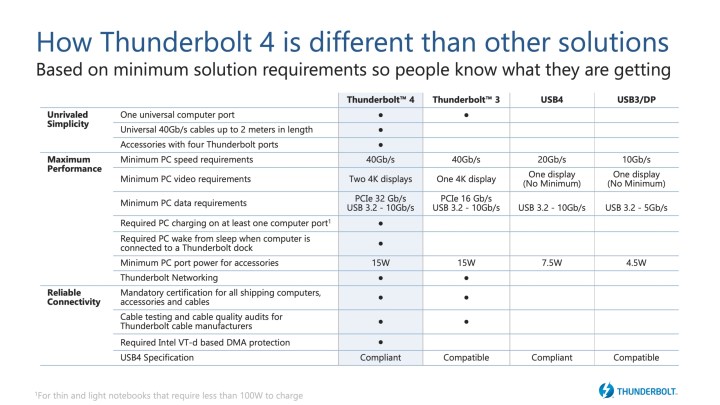Since Intel announced the upcoming Thunderbolt 4 as their new standard, there have been a lot of questions about how this new generation of ports will compare to its predecessor and other upcoming standards, like USB 4. It should be fast, but just how fast? And what else can it bring to the table?
Here’s everything we know about how Thunderbolt 4 works, what to expect, and how it will compare to the competition.
Availability

Intel officially announced Thunderbolt 4 at CES 2020. It stated that Thunderbolt 4 will first be supported by its upcoming Tiger Lake mobile processors, slated to debut at some point in 2020. It will join other technology improvements like native Wi-Fi 6 and Bluetooth 5 support.
While precise release dates haven’t been announced yet, Intel has released developer kits and certification testing for manufacturers and has announced the Thunderbolt 4 8000 series controller, which will work with all current
The first Thunderbolt 4 connections will appear on select laptops toward the end of 2020, including laptops from Intel’s Project Athena, a program made to encourage more innovative laptop designs that fit the modern lifestyle. 2021 will see a much broader array of choices for potential buyers interested in
Performance
As far as speed goes, Thunderbolt 4 will not be faster than Thunderbolt 3.
That’s somewhat of a surprise, as speed has been one of the major advantages of Thunderbolt 3, with its maximum capable throughput of 40 Gbps. In contrast, USB 3.2 2×2, the fastest specification of USB ports at the time of writing, is 20Gbps.
Intel later clarified that it would be four times faster than USB 3.2 Gen 2, which has a maximum speed of 10Gbps. Thunderbolt 4 will operate at a maximum throughput of 40Gbps.
However, you may still see a performance boost on your devices. That’s because one of the updates Intel has made is requiring Thunderbolt 4 to support PCIe bandwidth speeds of 32Gbps, twice what
Features

Thunderbolt is a standard jam-packed with features, from enabling external graphics cards to providing Ethernet network access, many designed to continue differentiating Thunderbolt from the USB standard. We already mentioned the new 32Gbps SSD connection speed, but for a device to be certified for
- Double minimum video data requirements compared to Thunderbolt 3. This will allow support for two 4k displays or an 8k display if necessary.
- Support for docks with up to four Thunderbolt 4 ports, more than Thunderbolt 3 requires.
- Wake features that allow you to immediately wake the computer at a touch of the keyboard or mouse when connected to a Thunderbolt dock (when this didn’t work with Thunderbolt 3 computer, it quickly became very annoying for frequent users and was a long-awaited fix).
- Protection against DMA or Direct Memory Attacks, a type of hack that taps into high-speed data connections on computers and steals data that passes through, recently highlighted in the enormous Thunderspy vulnerability — a collection of flaws found in Thunderbolt/USC connections going back almost a decade. For Thunderbolt 4, Intel requires that Virtualization for Directed I/O (VT-d), which creates a little separate memory pocket when transferring data to keep it isolated from hacking. While Thunderbolt 4 itself is a free spec, requiring this Intel technology to be included is an interesting move.
Editors' Recommendations
- The best HP laptops
- The most common Zoom problems and how to fix them
- The best tablets in 2023: top 9 picks you should buy
- Apple Reality Pro: everything we know about Apple’s VR headset
- What is Wi-Fi 7: Everything you need to know about 802.11be





